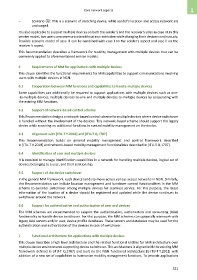Page 531 - 5G Basics - Core Network Aspects
P. 531
Core network aspects 1
− Scenario ④: This is a scenario of switching device, while sender's location and access network are
unchanged.
It is also applicable to support multiple devices on both the sender's and the receiver's sides as case III. In this
service model, two users can communicate without any restriction while changing their devices continuously.
Possible scenario model of case III can be combined with case I on the sender's aspect and case II on the
receiver's aspect.
This Recommendation describes a framework for mobility management with multiple devices that can be
commonly applied to aforementioned service models.
6 Requirements of MM for applications with multiple devices
This clause identifies the functional requirements for MM capabilities to support communications involving
users with multiple devices in NGN.
6.1 Cooperation between MM functions and capabilities to handle multiple devices
Some capabilities can additionally be required to support applications with multiple devices such as one-
-to-multiple devices, multiple devices-to-one and multiple devices-to-multiple devices by cooperating with
the existing MM functions.
6.2 Support of network-based control scheme
This Recommendation designs a network-based control scheme for multiple devices where device switchover
is handled without the involvement of the devices. This network-based scheme should support the legacy
device while requiring no additional functions to control mobility management on the device.
6.3 Alignment with [ITU-T Y.2018] and [ITU-T Q.1707]
This Recommendation builds on general mobility management and control framework described
in [ITU-T Y.2018] and network-based mobility management functionalities described in [ITU-T Q.1707].
6.4 Identification of user and multiple devices
It is required to manage identification capabilities in a network for handling multiple devices, logical set of
devices belonging to a user, and their relationship.
6.5 Support of the device switchover
In the general MM framework, each device tends to move across various access networks in NGN. Similarly,
this Recommendation can include location management and handover control functionalities in the MM
scheme to consider switchover among multiple devices for seamless service. For this purpose, the latest
information of the location of a device should be registered and updated while the device continues to
switchover around the network.
6.6 Support for authentication and authorization of user and devices
The MM schemes are recommended to support the authentication, authorization and accounting (AAA)
functionality to handle device switchover. For this purpose, the MM schemes can optionally interwork with
legacy AAA servers and/or user, device profile databases. These servers and databases may be used for the
authentication and authorization of the devices in case of switchover.
7 Functional architecture for applications with multiple devices
This clause describes a high level architecture and the related functional entities for MM architecture over
multiple device environments supporting device switchover. This architecture is aligned with the existing MM
framework defined in [ITU-T Q.1707] and built on the NGN functional architecture [b-ITU-T Y.2012] with
addition of a new set of capabilities to harmonize mobility management functions. To provide applications
521

